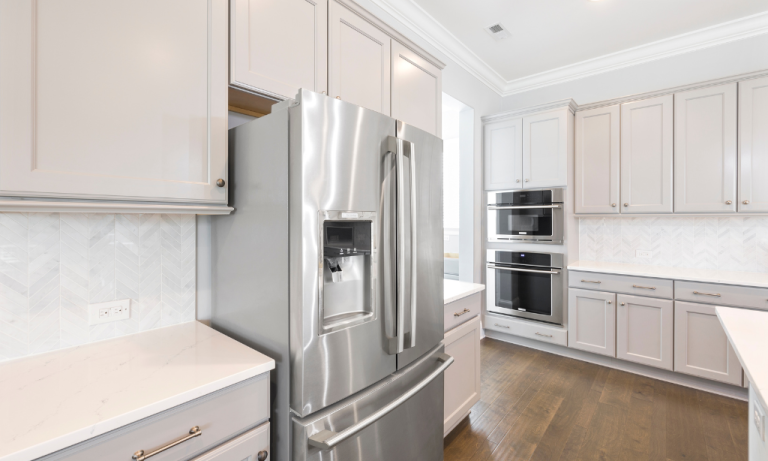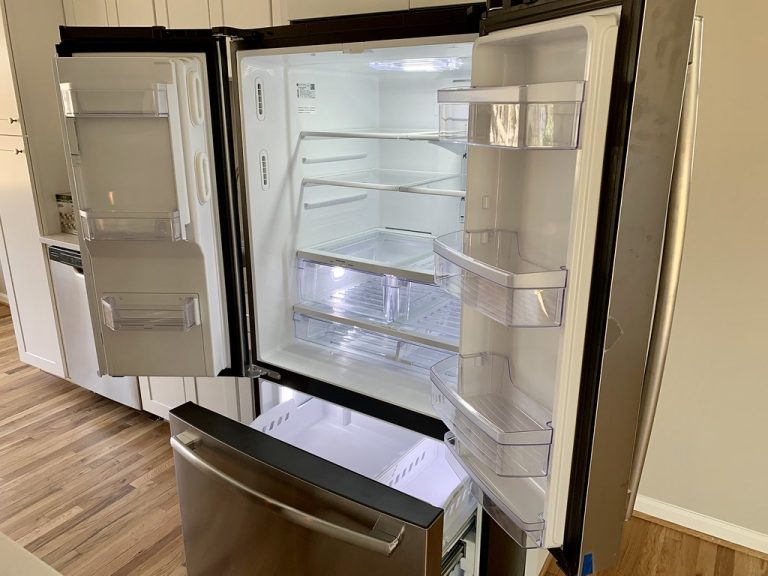Frigidaire Refrigerator Control Board [Troubleshooting Guide]
Frigidaire refrigerators have long been known for their reliability and efficiency in preserving perishables. At the heart of these appliances lies a critical component – the control board. This electronic brain orchestrates various functions, ensuring your refrigerator operates at its optimum. However, like any intricate system, control boards can encounter issues over time.
This troubleshooting guide aims to equip you with the knowledge and techniques to identify and address common control board-related problems. Whether you’re experiencing erratic temperature readings, display malfunctions, or other irregularities, this guide will walk you through step-by-step solutions.
Before delving into the troubleshooting process, it’s essential to understand the role of the control board and recognize the signs that it might be causing issues. Additionally, we’ll cover safety precautions and best practices to ensure a smooth troubleshooting experience.
What is a Refrigerator Control Board?
The control board, often referred to as the main control or electronic control board, is the central hub of your Frigidaire refrigerator’s electronic system. It acts as the brain, coordinating and regulating various components to maintain optimal temperature and performance. Essentially, it’s responsible for ensuring that your refrigerator operates efficiently and effectively.
Functions of the Control Board
- Temperature Regulation: The control board monitors and adjusts the temperature settings based on your preferences. It communicates with sensors to ensure that the refrigerator and freezer compartments maintain the desired temperatures.
- Defrost Cycle Control: It manages the defrost cycle, preventing the buildup of frost on the evaporator coils. This cycle is crucial for maintaining proper cooling efficiency.
- Fan and Compressor Operation: The control board regulates the operation of the condenser fan and compressor, ensuring they work together harmoniously to maintain consistent temperatures.
- Display and User Interface Management: For refrigerators with digital displays, the control board controls the display panel and interprets user inputs, allowing you to set temperature preferences and access additional features.
Common Control Board Components
- Microprocessor: This is the heart of the control board. It processes information from various sensors and user inputs, making real-time adjustments to maintain optimal conditions.
- Relays and Switches: These are responsible for controlling the flow of electricity to various components like the compressor, fans, and defrost heater.
- Capacitors and Resistors: These electronic components work in tandem to regulate voltage and current flow, ensuring the control board functions correctly.
- Sensors: These devices provide crucial data to the control board, including temperature readings from different areas of the refrigerator.
Signs of Control Board Issues
The control board plays a pivotal role in ensuring your refrigerator operates seamlessly. When it encounters problems, it can manifest in various ways. Recognizing these signs is crucial for timely intervention and troubleshooting.
Refrigerator Not Cooling Properly
1. Temperature Fluctuations
- Inconsistent Cooling: If you notice that the refrigerator’s temperature fluctuates significantly, it may indicate a control board issue. The board may struggle to maintain a steady temperature setting.
- Items Spoiling Prematurely: Perishables spoiling faster than usual can be a sign of inconsistent cooling, which is often linked to control board problems.
2. Warm Spots in the Refrigerator
- Uneven Cooling: Some areas of the refrigerator may be noticeably warmer than others. This could be due to a control board failing to distribute cool air evenly.
Inconsistent Freezer Temperatures
- Frozen Items in the Refrigerator Section: If you find items in the refrigerator compartment are freezing, it’s a clear indication of temperature regulation issues, potentially linked to the control board.
- Freezer Not Maintaining Adequate Coldness: A freezer that struggles to reach or maintain its desired temperature can be a sign that the control board is not functioning properly.

Display Panel Malfunctions
1. Error Codes
- Displaying Error Messages: If your refrigerator has a digital display panel, it may show error codes. These codes are a key indicator of potential control board problems.
2. Blank Display
- No Response from the Display: A completely blank display panel or unresponsive buttons may suggest a malfunctioning control board or a power supply issue.
Basic Troubleshooting Steps
Before delving into advanced techniques, there are some initial steps you can take to address control board-related issues. These fundamental troubleshooting measures can often resolve minor problems.
Power Source Check
- Verify Power Connection: Ensure that the refrigerator is properly plugged into a functioning electrical outlet. Check for any loose or damaged cords.
- Circuit Breaker Inspection: Confirm that the circuit breaker or fuse associated with the refrigerator has not tripped or blown. If so, reset or replace it.
Inspecting for Loose Connections
- Unplug the Refrigerator: As a safety precaution, disconnect the refrigerator from the power source.
- Access the Control Board: Depending on the model, locate the control board typically at the back of the refrigerator or behind a panel inside the fridge.
- Examine Wiring and Connections: Gently inspect the wiring and connections on the control board for any signs of wear, looseness, or damage.
- Re-Secure Loose Connections: If you find any loose wires or connectors, carefully reattach them. Ensure they fit snugly.
Resetting the Control Board
- Power Off the Refrigerator: Unplug the refrigerator from the electrical outlet.
- Wait for a Few Minutes: Allow a few minutes to pass before plugging the refrigerator back in. This brief pause can help reset the control board.
- Power On the Refrigerator: Plug the refrigerator back in and power it on. Observe if there are any changes in its operation.
Checking for Burnt or Discolored Components
- Inspect the Control Board: Examine the control board for any visible signs of damage, such as burnt or discolored areas. This can indicate a faulty component.
- Document Findings: If you identify any damaged components, take note of their location and appearance for reference.
Read also 11 Refrigerator Brands to Avoid and Explained Why!

Multimeter Usage for Testing Voltage
- Select the Voltage Setting: Set the multimeter to the appropriate voltage range. For most household appliances, the AC voltage setting is suitable.
- Turn on the Refrigerator: Plug in the refrigerator and turn it on.
- Locate Control Board Components: Identify the components you want to test. This may include relays, capacitors, and resistors.
- Testing Procedure:
Relays:
- Place the multimeter probes on the relay terminals.
- Check for a reading within the specified range. A lack of continuity indicates a faulty relay.
Capacitors:
- Ensure the capacitor is discharged (short the terminals with a screwdriver).
- Set the multimeter to the capacitance setting.
- Connect the probes to the capacitor terminals.
- Compare the reading to the labeled capacitance value.
Resistors:
- Set the multimeter to the resistance setting.
- Place the probes on either end of the resistor.
- Compare the reading to the labeled resistance value.
Testing Individual Control Board Components
Relays:
- Function:
- Relays control the flow of electricity to various components.
- Testing:
- Use the multimeter to check for continuity across the relay terminals. A lack of continuity indicates a faulty relay.
Capacitors:
- Function:
- Capacitors store and release electrical energy.
- Testing:
- Measure capacitance using the multimeter. Any significant deviation from the labeled value may indicate a faulty capacitor.
Resistors:
- Function:
- Resistors limit the flow of electrical current.
- Testing:
- Use the multimeter to measure resistance. Compare the reading to the labeled resistance value.

Maintenance Tips to Prevent Control Board Issues
Regular maintenance is key to ensuring the longevity and optimal performance of your Frigidaire refrigerator’s control board. By following these simple tips, you can reduce the likelihood of encountering control board problems in the future.
Cleaning and Dusting the Control Board
- Power Off the Refrigerator: Before performing any maintenance, unplug the refrigerator from the electrical outlet to ensure safety.
- Access the Control Board: Depending on the model, locate and open the panel covering the control board. It’s usually located at the back of the refrigerator or behind a panel inside the fridge.
- Use Compressed Air or a Brush: Gently blow compressed air or use a soft brush to remove dust, dirt, and debris from the control board and surrounding components.
- Inspect for Residue or Corrosion: Check for any signs of residue or corrosion on the control board or its components. If found, clean them using a soft, lint-free cloth and a mild cleaning solution.
Regular Inspections
- Check for Loose Connections: Periodically inspect the wiring and connections on the control board. Tighten any loose wires or connectors that you may find.
- Examine for Wear and Tear: Look for signs of wear, such as frayed wires, corroded terminals, or damaged components. Address any issues promptly.
Avoiding Overloading the Refrigerator
- Maintain Proper Air Circulation: Avoid overcrowding the refrigerator, as this can impede air circulation, leading to uneven cooling and potential strain on the control board.
- Don’t Block Ventilation Areas: Ensure that vents and air passages in the refrigerator are not obstructed by food items or containers.
- Monitor Door Seal Integrity: A faulty door seal can cause the refrigerator to work harder to maintain the desired temperature, potentially leading to control board stress. Replace damaged seals promptly.
People Also Ask
What is the purpose of the control board in a Frigidaire refrigerator?
The control board, also known as the main control or electronic control board, is the central component that regulates and coordinates various functions in a Frigidaire refrigerator. It is responsible for tasks such as temperature regulation, defrost cycle management, and controlling the operation of the compressor and fans. Essentially, it ensures the refrigerator operates efficiently and maintains optimal conditions.
Can I troubleshoot the control board on my own, or should I seek professional help?
Basic troubleshooting steps, such as checking power connections and inspecting for loose wires, can be done by individuals with some technical proficiency. However, for more advanced troubleshooting involving the use of a multimeter or component testing, it’s recommended to have some experience or consult a certified technician. If you’re unsure or uncomfortable with the process, it’s best to seek professional assistance.
How often should I perform maintenance on the control board?
Regular maintenance is crucial to prevent control board issues. We recommend cleaning and dusting the control board at least once every six months. Additionally, perform visual inspections for loose connections or signs of wear and tear during routine cleaning.
What safety precautions should I take when troubleshooting the control board?
Always prioritize safety when working with electrical components. Before starting any troubleshooting, unplug the refrigerator from the electrical outlet. Use insulated gloves and tools when handling electrical components. If you’re unsure about any step, consult the manufacturer’s guidelines or seek professional assistance.
What if I’ve followed all troubleshooting steps and still can’t resolve the issue?
If you’ve exhausted all troubleshooting options and the control board issues persist, it’s recommended to contact a certified technician. They have the expertise and specialized equipment to diagnose and resolve complex electronic problems.
As an Amazon Associate I earn from qualifying purchases.
- Can You Put Clouds Shoes in the Washing Machine? With Tips & Tricks - April 10, 2024
- European Washing Machine vs American – History, Design, Technology - March 27, 2024
- Can You Put Boxing Gloves In The Washing Machine? – Expert Tips - March 25, 2024

![Frigidaire Refrigerator Control Board [Troubleshooting Guide]](https://homeplacetips.com/wp-content/uploads/2023/11/Frigidaire-Refrigerator-Repair-No-Power-Power-Control-Board_000113387.webp)


![Brand New Fridge Making Noise [Easy Fix]](https://homeplacetips.com/wp-content/uploads/2024/01/LG-Refrigerators-Understanding-Noises-From-An-LG-Refrigerator_000074741-768x432.webp)

![Whirlpool Refrigerator Water Dispenser Not Working After Replacing Filter [2024]](https://homeplacetips.com/wp-content/uploads/2023/12/Refrigerators-You-Should-Never-Buy_000098922-768x432.webp)
